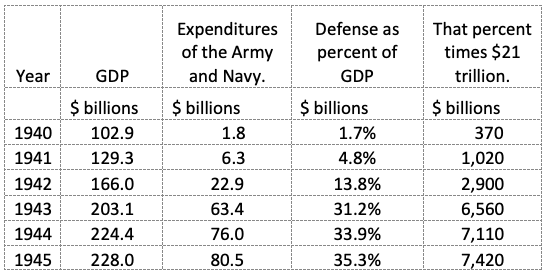The March 11th column by David Brooks in the New York Times stated that:
“As Michael Hendrix of the Manhattan Institute notes, America spent $4.8 trillion in today’s dollars fighting World War II. Over the past year, America has spent over $5.5 trillion fighting the pandemic.”
This is the worst possible use of using the CPI to compare relative worth (See the essay on this issue on our website.)
It makes far more sense to use the GDP to compare these expenditures. This table shows the GDP and armed forces expenditures for the war years in current year values. The third column reports those expenditures as a percent of GDP. The last column is that percent times the today’s GDP of $21 trillion.
For three years the war expenses are over 30% of GDP . If we take the relative GDP share of these expenditures during the four years from 1942 to 1945, the total of those numbers is $24 trillion, four times the $6 trillion to be spent on relief today.
WWII was a period in our history where this country expended more of its resources and suffered more sacrifices to defeat an enemy than any time since the Civil War. It is ridiculous to compare it to the outlays today.
